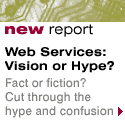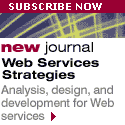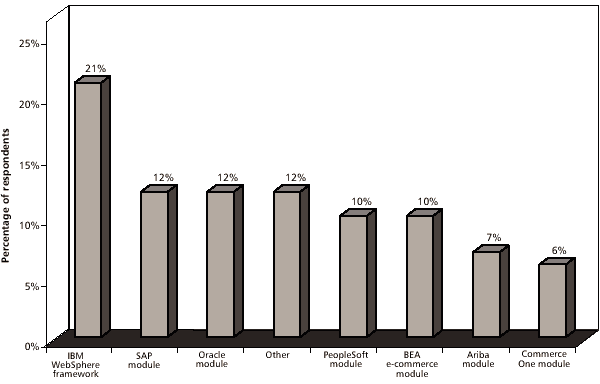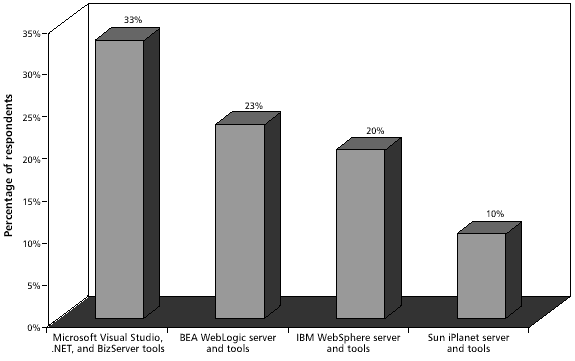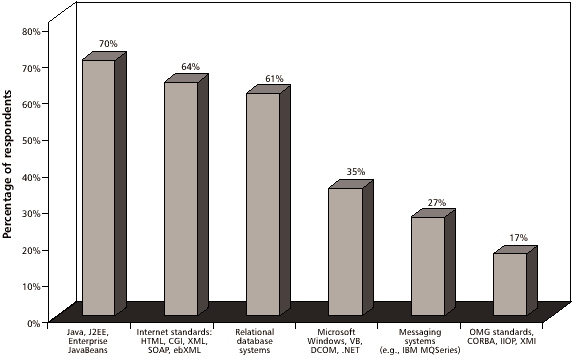 « Advisory Service Home | |||||
Vol. 4, No. 20E-BUSINESS PACKAGES, TOOLS, AND TECHNOLOGIESby Paul Harmon, Senior Consultant, Cutter Consortium
I began reviewing Cutter Consortium's recent e-business survey this past September. In Executive Update Vol. 4, No. 18, I reported that 74% of respondents (some 140 companies once I eliminated software companies and consultants from our sample) were firmly committed to e-business as a key part of their corporate strategies. In Executive Update Vol. 4, No. 19, I reviewed the kinds of e-business applications being developed by companies and the kinds of modules (or functions) being included in those applications. In this Update, I want to consider the kinds of off-the-shelf (OTS) packages, software development tools, and technologies that our respondents are using to develop e-business applications. We asked respondents to tell us whether they used OTS packaged applications or component frameworks to develop their e-business applications. The results are presented in Figure 1.
Keep in mind as your review the results that most companies are developing e-commerce and internal applications and far fewer have developed supply chain applications. Also keep in mind that most have developed or are developing relatively simple applications and plan to add more functionality later. In the development of these basic applications, companies have used a mix of packaged applications, like those from SAP, Oracle, and PeopleSoft, and component frameworks from IBM and BEA. Increasingly, as the packaged vendors add standard interfaces to their modules, the modules function more like business components, and the distinction blurs. Neverthe-less, if we add IBM and BEA together, we get 31%. If we add SAP, Oracle, and PeopleSoft together, we get 34%. So, relatively equal numbers are choosing to: 1) use components to get more flexibility, and 2) use packaged modules to obtain faster, standardized results. We also asked respondents which tools they used to develop their e-business applications. Figure 2 provides the results.
Somewhat surprisingly, when you consider the answers in Figure 1, about one-third of the respondents indicated they were using Microsoft tools, 23% reported they were using BEA WebLogic and its tools, and only 20% indicated they were using IBM WebSphere tools. Let's assume that the 21% that said they were using IBM's WebSphere framework are about the same as the 20% that are using WebSphere tools. Apparently, many companies that are using SAP, Oracle, PeopleSoft, and other modules are using Microsoft tools to handle the interfaces to users. Presumably, many companies are using BEA's WebLogic server and tools, but not using the BEA e-commerce modules. That makes sense if you consider that many of the applications fielded to date are little more than Web sites or portals that provide basic information about the company. If you add BEA, IBM, and Sun users together, you get 53%, so more companies are using non-Microsoft tools than Visual Studio, .NET, and BizServer. Finally, we asked companies what technologies they were using, without regard to specific tools or frameworks. The results are shown in Figure 3.
The greatest number of respondents, 70%, indicated that they were using Java, Java 2 Enterprise Edition (J2EE), and Enterprise JavaBeans. This is in line with numerous surveys that show that Java dominates e-business development efforts. When you compare this result with the finding that 33% are using Microsoft tools, which aren't usually the tools of choice for Java development, it underlines our suspicion that most Microsoft tool use is confined to interfaces and linkages for OTS e-business applications, and not for general application development. According to our results, 64% of respondents indicated that they were using Internet protocols, while 61% indicated they were using relational databases. This isn't surprising. Additionally, 35% indicated they were using Microsoft technologies, which, once again, loosely corresponds to those using Microsoft tools. Some 27% were using messaging systems like IBM's popular MQSeries. Many if not most of these developers are probably working on more complex systems with mainframe servers, or using OTS supply chain products. And finally, 17% of developers reported that they were using Object Management Group technologies, including CORBA, IIOP, and XMI. This also fits with several reports. CORBA isn't very popular with e-business developers. Instead, it's used internally to wire legacy applications together. Of course, IIOP is used in J2EE to link Java code to legacy code and some of the companies using Java probably have some CORBA in their applications, but, overall, CORBA is clearly playing a secondary role in e-business application development. There is little that is surprising in this data. Those following reports in the popular press will probably expect it. Once again, it's worth emphasizing that so far respondents have focused on building relatively simple e-business applications. These are the kinds of applications that can be done quickly with simpler technologies and OTS packages. As companies begin to extend those applications or create more ambitious applications, the profile of tool and technology use will probably change slightly. Overall, however, this data models our recommendations to clients. Mastering Java and its associated technologies is one of the keys to successful e-business development. The use of application servers from IBM and BEA have proven to be the most popular and should certainly be explored, if they are not already being used. Microsoft shops will stick with Microsoft tools and technologies, although the dominance of Microsoft technologies in e-business development has shrunk as Microsoft has moved away from Java. This may change as companies learn more about Web services and decide to use them, but at the moment, Java is playing the leading role, and other technologies are being used to supplement or extend it. Finally, in spite of our initial skepticism, the packaged software vendors are succeeding in converting to Internet and component technologies and playing a growing role in e-business development. The customer relationship management and supply chain management offerings of the major packaged software should be carefully monitored. If they fit the bill, then it's better to buy and reuse than to develop from scratch. ABOUT THE AUTHOR | |||||
Back to Top © 2002 Cutter Consortium. All rights reserved. Comments/suggestions to webmaster@cutter.com. |

